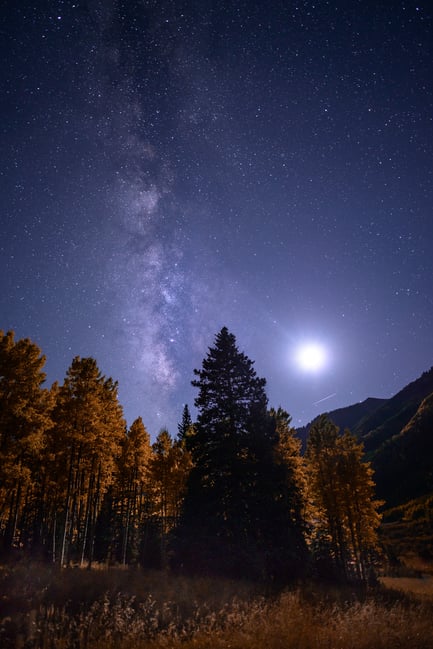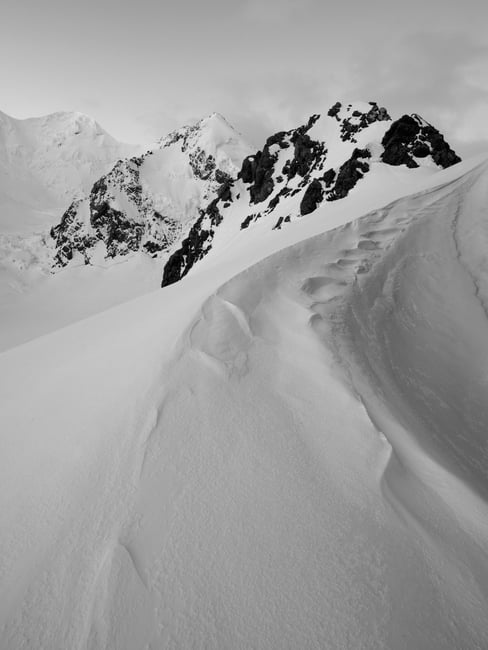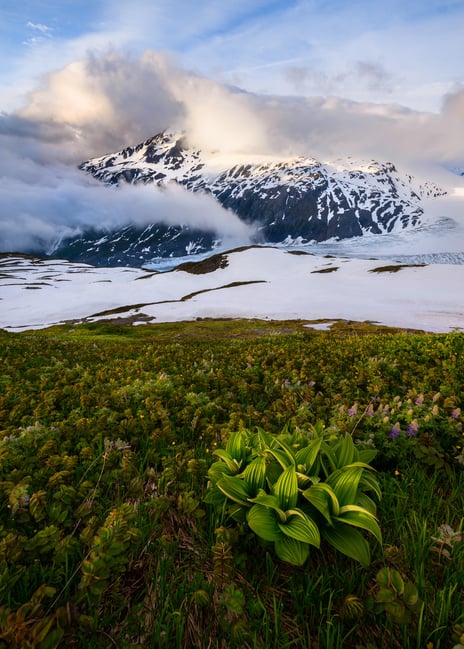
As a beginner photographer, you might have heard of such terms as f-stop or f-number and wondered what they actually mean. In this article, we will dive into these in detail and talk about how to use them for your photography.
Table of Contents
Why Aperture is Important
As we have previously defined, aperture is basically a hole in your camera’s lens that lets light pass through. It’s not a particularly complicated topic, but it helps to have a good mental concept of aperture blades in the first place.
Yes, aperture blades, which are also known as the diaphragm in optics.
Take a look inside your camera lens. If you shine a light at the proper angle, you’ll see something that looks like this:
These blades form a small hole, almost circular in shape — your aperture. They also can open and close, changing the size of the aperture.
That is an important concept! Often, you’ll hear other photographers talking about large versus small apertures. They will tell you to “stop down” (close) or “open up” (widen) the aperture blades for a particular photo.
As you would expect, there are differences between photos taken with a large aperture versus photos taken with a small aperture. Aperture size has a direct impact on the brightness of a photograph, with larger apertures letting in more light into the camera compared to smaller ones. However, that isn’t the only thing that aperture affects.
The other more important impact is depth of field – the amount of your photo that appears to be sharp from front to back. For example, the two illustrations below have different depths of field, depending on the size of aperture:

Adjusting your aperture is one of the best tools you have to capture the right images. You can adjust it by entering your camera’s aperture-priority mode or manual mode, both of which give you free rein to pick whatever aperture you like. That is why I only ever shoot in aperture-priority or manual modes!
Before you try it out for yourself, though, there are a few other things you might want to know.
What is F-Stop?
The f-stop, which is also known as the f-number, is the ratio of the lens focal length to the diameter of the entrance pupil. If you did not understand that, don’t worry, because there is a much easier explanation of it for beginners. In very simple language, f-stop is the number that your camera shows you when you change the size of the lens aperture.
You might have seen this in your camera before. On your camera’s LCD screen or viewfinder, the f-stop looks like this: f/2.8, f/4, f/5.6, f/8, f/11, and so on. Sometimes, it will be shown without a slash in between like f2.8, or with a capital “F” letter in the front like F2.8, which means the exact same thing as f/2.8. These are just examples of different f-stops, and you might come across much smaller numbers like f/1.2 or much larger ones like f/64.

Why is Aperture Written as an f-number?
Why is your aperture written like that? What does something like “f/8” even mean? Actually, this is one of the most important parts about aperture: it’s written as a fraction.
You can think of an aperture of f/8 as the fraction 1/8 (one-eighth). An aperture of f/2 is equivalent to 1/2 (one-half). An aperture of f/16 is 1/16 (one-sixteenth). And so on.
Hopefully, you know how fractions work. 1/2 cup of sugar is much more than 1/16 cup of sugar. A 1/4 pound burger is larger than a 1/10 pound slider.
By that same logic, an aperture of f/2 is much larger than an aperture of f/16. If you ever read an article online that ignores this simple fact, you’ll be very confused.
Pop quiz: Which aperture is larger — f/8 or f/22?
You already know the answer to this question, because aperture is a fraction. Clearly, 1/8 is larger than 1/22. So, f/8 is the larger aperture.
If someone tells you to use a large aperture, they’re recommending an f-stop like f/1.4, f/2, or f/2.8. If someone tells you to use a small aperture, they’re recommending an f-stop like f/8, f/11, or f/16.
See the below diagram that shows different sizes of aperture to understand:

What Does the “f” Stand For?
A lot of photographers ask me an interesting question: What does the “f” stand for in f-stop, or in the name of aperture (like f/8)?
Quite simply, the “f” stands for “focal length”. When you substitute focal length into the fraction, you’re solving for the diameter of the aperture blades in your lens. (Or, more accurately, the diameter that the blades appear to be when you look through the front of the lens).
For example, say that you have an 80-200mm f/2.8 lens fully zoomed out to 80mm. If your f-stop is set to f/4, the diameter of the aperture blades in your lens will look exactly 20 millimeters across (80mm / 4), whereas at f/16, the diameter will be reduced to mere 5 millimeters (80mm / 16).
This is a cool concept. It also makes it easy to visualize why an aperture of f/4 would be larger than an aperture of f/16. Physically, at f/4, your aperture blades are open much wider, as shown below:

Which F-Stop Values Can You Actually Set?
Unfortunately, you can’t just set any f-stop value that you want. At some point, the aperture blades in your lens won’t be able to close any smaller, or they won’t be able to open any wider.
Typically, the “maximum” aperture of a lens, which is also often referred to as “wide-open” aperture, will be something like f/1.4, f/1.8, f/2, f/2.8, f/3.5, f/4, or f/5.6.
A lot of photographers really care about the maximum aperture that their lenses offer. Sometimes, they’ll pay hundreds of extra dollars just to buy a lens with a maximum aperture of f/2.8 rather than f/4, or f/1.4 rather than f/1.8.
Why is large maximum aperture in a lens so important? Because a lens with a larger maximum aperture lets more light into the camera. For example, a lens with a maximum aperture of f/2.8 lets in twice as much light when compared to a lens with a maximum aperture of f/4.0. This difference could be a big deal when shooting in low-light conditions.
Since people care so much about maximum aperture, camera manufacturers decided to include that number in the name of the lens. For example, one of my favorite lenses is the Nikon 20mm f/1.8G. The largest aperture it offers is f/1.8.

If you have a 50mm f/1.4 lens, the largest aperture you can use is f/1.4. Professional constant aperture zoom lenses like a 24-70mm f/2.8 will have f/2.8 as their maximum aperture at every focal length. Whereas cheaper consumer-grade lenses such as 18-55mm f/3.5-5.6 will have their maximum aperture change depending on focal length. At 18mm, the maximum is at f/3.5, while at 55mm, it changes to f/5.6. In between is a gradual shift from one to the other.
Photographers generally don’t care as much about the smallest or “minimum” aperture that the lens allows, which is why manufacturers don’t put that information in the name of the lens. However, if it matters to you, you will always be able to find this specification on the manufacturer’s website. A lens’s smallest aperture is typically something like f/16, f/22, or f/32.
F-Stop and Depth of Field
Along with the amount of light a lens aperture allows, it has one other huge effect on your photos – depth of field.
I always find that it’s easiest to understand depth of field by looking at photos, such as the comparison below. In this case, I used a relatively large aperture of f/4 for the photo on the left, and an incredibly small aperture of f/32 for the photo on the right. The differences should be obvious:

This is very interesting! As you can see, in the f/4 photo, only a thin slice of the lizard’s head appears sharp. The background of the photo is very blurry. This is known as depth of field.
You can think of depth of field as a glass window pane that intersects with your subject. Any part of your photo that intersects with the window glass will be sharp. The thickness of the glass changes depending upon your aperture. At something like f/4, the glass is relatively thin. At something like f/32, the glass is very thick. Also, depth of field falls off gradually rather than dropping sharply, so the window glass analogy is definitely a simplification.
This is why portrait photographers love f-stops like f/1.4, f/2, or f/2.8. They give you a pleasant “shallow focus” effect, where only a thin slice of your subject is sharp (such as your subject’s eyes). You can see how that looks here:

On the flip side, you should be able to see why landscape photographers prefer using f-stops like f/8, f/11, or f/16. If you want your entire photo sharp out to the horizon, this is what you should use.

What is the Aperture Scale?
Here’s the aperture scale. Each step down lets in half as much light:
- f/1.4 (very large opening of your aperture blades, lets in a lot of light)
- f/2.0 (lets in half as much light as f/1.4)
- f/2.8 (lets in half as much light as f/2.0)
- f/4.0 (etc.)
- f/5.6
- f/8.0
- f/11.0
- f/16.0
- f/22.0
- f/32.0 (very small aperture, lets in almost no light)
These are the main aperture “stops,” but most cameras and lenses today let you set some values in between, such as f/1.8 or f/3.5.
If you’d prefer to see that information in a chart, here you go:
| f/1.4 | f/2.0 | f/2.8 | f/4.0 | f/5.6 | f/8.0 | f/11.0 | f/16.0 | f/22.0 |
|---|---|---|---|---|---|---|---|---|
| Very large aperture | Large aperture | Large aperture | Moderate aperture | Moderate aperture | Moderate aperture | Small aperture | Small aperture | Very small aperture |
| Lets in a huge amount of light | Half as much light | Half as much light | Half as much light | Half as much light (a very “medium” aperture) | Half as much light | Half as much light | Half as much light | Half as much light (by which point your photos are very dark) |
| Very thin depth of field | Thin depth of field | Thin depth of field | Moderately thin depth of field | Moderate depth of field | Moderately large depth of field | Large depth of field | Large depth of field | Very large depth of field |
Usually, the sharpest f-stop on a lens will occur somewhere in the middle of this range — f/4, f/5.6, or f/8. However, sharpness isn’t as important as things like depth of field, so don’t be afraid to set other values when you need them. There’s a reason why your lens has so many possible aperture settings.
Other Effects of F-Stop
The second page of our aperture article dives into every single effect of aperture in your photos. It includes things like diffraction, sunstars, lens aberrations, and so on. However, as important as all that is, it’s not what you really need to know – especially at first.
Instead, just know that the two biggest reasons to adjust your aperture are to change brightness (exposure) and depth of field. Learn those first. They have the most obvious impact on your images, and you can always read about the more minor effects later.
Conclusion
Hopefully, you now have a good sense of f-stop and the ways it affects your photos. To recap:
- F-stop (aka f-number) is the number that you see on your camera or lens as you adjust the size of your aperture.
- Since f-stops are fractions, an aperture of f/2 is much larger than an aperture of f/16.
- Just like the pupil in your eye, a large aperture lets in a lot of light. If it’s dark out, and you don’t have a tripod, you’ll want to use a large aperture, something like f/1.8 or f/3.5.
- Your lens has a maximum and minimum aperture that you can set. For something like the Nikon 50mm f/1.8G lens, the maximum aperture is f/1.8, and the minimum aperture is f/16. You can’t set anything beyond that range.
- In addition to the amount of light aperture passes through, it also affects depth of field – how much of the image appears to be in focus. Large apertures like f/1.8 have a very thin depth of field, which is why portrait photographers like them so much. Landscape photographers prefer using smaller apertures, like f/8, f/11, or f/16, to capture both the foreground and background of a scene as sharp as possible at the same time.
- There are other effects of aperture, too, but exposure and depth of field are generally the most important.
That’s it! If you understand the basic bullet points, you’ve got the basics of f-stop and aperture.
Of course, putting everything into practice is another matter. Even if this entire article makes sense for now, you’ll still need to take hundreds of photos in the field, if not thousands, before these concepts become completely intuitive.
Luckily, you have the building blocks. Aperture and f-stop aren’t complicated topics, but they can seem a bit counterintuitive for photographers who are just starting out. Hopefully, this article clarified some of the confusion, and you now have a better understanding of the fundamentals of aperture.
Below are some examples of photographs captured at different f-stops from f/2.8 to f/16, to give you an idea of how they are used in the field:




Very helpful and thorough information about aperture for a total beginner. Thank you very much Spencer.
Just learning how to use my eso100m cannon. This really made sense to me, thank you
Thank you for making a taboo a clear and simple. Great article.
I loved this article…simple and easy to follow…while also answering my f-stop questions. MANY thanks.
really helpful article, I too am just starting out and found this so useful. Thanks.
Thank you so much for explaining this topic in a way I finally understand ! I have just started photography using a Nikon d3200 with 70-300mm lens primarily for wildlife .. I wish I had read this article before I started !
You’re welcome! I’m glad it was useful. I hope you enjoy your new camera and your journey as a photographer!
VERY helpful article for this novice. As you are in Colorado, perhaps you can help on this topic: I’m going on a northern lights tour in a few weeks, and am considering getting a camera better than my iPhone. I’ve read many articles recommending various cameras (Sony a6000 keeps coming up), but then when looking at specs, most [affordable in my budget] cameras state an operating temperature only down to 32f. I’ll be in Norway with tens in the teens and 20’s. Are the manufacturer specs to be taken seriously for real-world use? Would I ruin a camera using it in temps 20 degrees cooler than its rating?
That’s a great question. I constantly use my cameras in colder weather than 32F, no matter what they’re rated for. Even sub-zero temperatures (still talking Fahrenheit) don’t concern me, although I don’t think the camera warranty would still apply if something did go wrong in those temperatures.
One of my friends once had the mirror of his DSLR break in extremely cold weather – not a problem with mirrorless cameras, of course.
Sooo thaats it ! I always thought the ants knew it – go here go there go there go here and always at home! thanks a lot
Thank you so much! I’m not afraid anymore to play with F Stop.
Thanks for the explanation. As a newbie I could not figure out why the aperture number increased in value even though the opening decreased. Knowing now that the value is actually a fraction has eliminated the confusion.